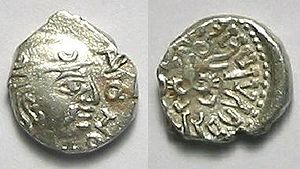Kumaragupta I.

King Kumaragupta I (also Kumara Gupta , Mahendraditya ; † 455 ) ruled the north Indian empire of the Gupta between 415 and 455. The son of Chandragupta II had a long reign in which the empire was internally consolidated.
swell
The inscription of Bilsad is the oldest evidence of his rule; it goes back to the year 96 of the Gupta era, the year 415. Other mentions of his name can be found on his undated coins and on a Yaksha statue from Mathura .
Life
Kumaragupta I. was - like his father and grandfather - a follower of Vishnuism ; on some gold coins, however, also a portrait of the place - more like the Shaivism attributable to - god of war Karttikeya on his mount ( vahana ), the peacock. Although Hindu, Kumaragupta was known for its religious tolerance and extensive endowments to Buddhist and Jainist monasteries. He and his father are considered to be the founder of many temples, which are now grouped under the term Gupta temple . Some of these temple cities ( Nachna , Eran ) were conceived from the outset as regional cult centers or developed in this direction, but most of the others remained individual buildings ( Bhumara , Gop). The Buddhist monasteries developed into financial centers - dependent on the urban economy - and the Hindu monasteries came up trumps with rapidly growing land holdings.
At the end of Kumaragupta's reign, Prince Skandagupta had already saved his father's empire from a major tribal uprising of the Pushyamitras on the Narmada River. According to an inscription, Kumaragupta I. is said to have died in a battle of the hunts, the same inscription tells of Skandagupta's victory over the "Huns" ( Huna ). "Huns" are not to be understood as the Huns advancing into Eastern Europe around 375 , but rather parts of the so-called Iranian Huns ; this term goes back to the numismatic research of Robert Göbl . Specifically, it may well have been the so-called Alchon group, which aggressively expanded into north-west India in the early 6th century. Skandagupta (ruled 455-467) ousted the Crown Prince Purugupta and went down in history in 458 with the defense of the Huns as the penultimate Gupta king.
literature
- Hermann Kulke , Dietmar Rothermund : History of India. From the Indus culture to today. 2nd, updated edition of the special edition. CH Beck, Munich 2010, ISBN 978-3-406-60414-0 .
- Fred Virkus: Political structures in the Gupta empire . (300–550 AD) (= Asia and Africa Studies at the Humboldt University in Berlin. 18) Harrassowitz, Wiesbaden 2004, ISBN 3-447-05080-2 .
Web links
- Kumaragupta I. and Skandagupta (Eng.)
- Biography Kumaraguptas I. (Engl.)
- Coinage Kumaraguptas I. - Photos and information (Engl.)
Remarks
- ^ Robert Göbl : Documents on the history of the Iranian Huns in Bactria and India. 4 volumes. Harrassowitz, Wiesbaden 1967.
| predecessor | Office | successor |
|---|---|---|
| Chandragupta II |
King of the Gupta 415-455 |
Skandagupta |
| personal data | |
|---|---|
| SURNAME | Kumaragupta I. |
| ALTERNATIVE NAMES | Mahendraditya; Kumara Gupta I. |
| BRIEF DESCRIPTION | Ruler of the north Indian empire of the Gupta (415–455) |
| DATE OF BIRTH | 4th century or 5th century |
| DATE OF DEATH | 455 |